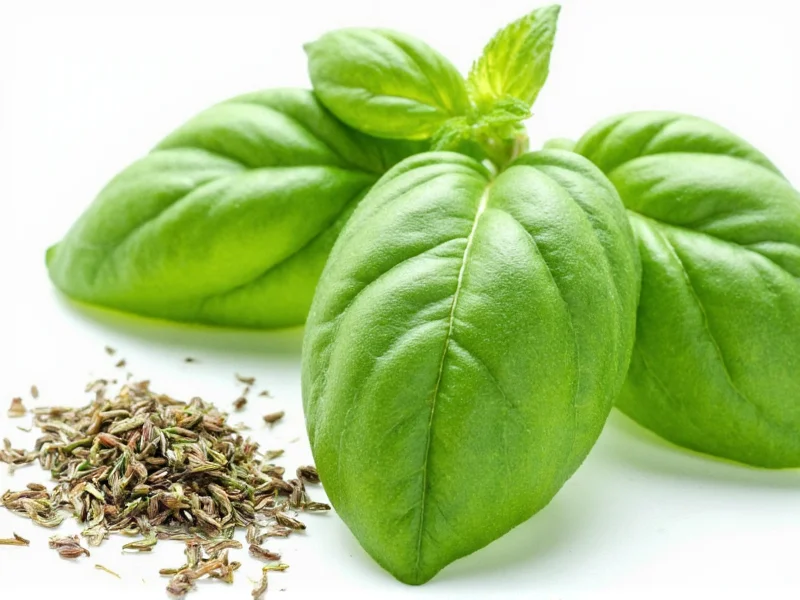Understanding how to properly substitute dried basil for fresh basil is essential for maintaining recipe integrity when your preferred form isn't available. The key difference lies in moisture content—fresh basil contains about 90% water, while dried basil has most moisture removed, concentrating its essential oils and flavor compounds.
Why Dried and Fresh Basil Measurements Differ
Drying basil removes moisture but intensifies certain flavor compounds while diminishing others. The volatile oils that give basil its characteristic aroma become more concentrated, making dried basil more potent by volume. However, fresh basil offers brighter, more complex flavor notes that dried basil cannot fully replicate.
Dried Basil to Fresh Basil Conversion Chart
| Measurement | Fresh Basil | Dried Basil |
|---|---|---|
| Teaspoon | 3 tsp | 1 tsp |
| Tablespoon | 1 tbsp | 1 tsp |
| Cup | 1 cup | ⅓ cup |
| Ounce | 1 oz | ⅓ oz |
Flavor Profile Comparison
Fresh basil delivers bright, sweet, and slightly peppery notes with hints of anise and clove. Dried basil develops earthier, more muted flavors with less complexity. The drying process particularly diminishes the volatile compounds responsible for fresh basil's signature aroma.
When substituting dried for fresh basil in your cooking, consider these factors:
- Timing matters: Add dried basil early in cooking to allow rehydration and flavor dispersion
- Moisture adjustment: Recipes using dried basil may need slightly more liquid
- Flavor development: Dried basil benefits from longer cooking times to fully release flavors
- Final adjustment: Always taste before serving and adjust seasoning as needed
Best Practices for Substituting Basil Forms
Not all recipes respond equally well to basil substitutions. Understanding when to use each form ensures optimal results in your culinary creations.
When Dried Basil Works Well as a Substitute
Dried basil performs best in dishes with longer cooking times where its concentrated flavor can disperse evenly:
- Tomato-based sauces simmered for 30+ minutes
- Slow-cooked stews and braises
- Dry rubs for meats
- Bread doughs and baked goods
- Preserved foods like pesto that will be frozen
When to Avoid Substituting Dried for Fresh Basil
Certain dishes require fresh basil's delicate flavor profile that dried basil cannot replicate:
- Cold dishes like caprese salad
- Finishing touches on completed dishes
- Pesto where fresh texture matters
- Delicate seafood preparations
- Raw applications like fresh herb blends
Storage Considerations for Basil Forms
Proper storage affects both forms' usability as substitutes. Fresh basil keeps for 3-5 days refrigerated with stems in water (like flowers), while properly stored dried basil maintains quality for 1-2 years in an airtight container away from light and heat.
Revive stale dried basil by warming it briefly in a dry pan before use—this reactivates essential oils. For fresh basil substitutions, remember that slightly wilted fresh basil still works well in cooked applications where texture matters less.
Common Substitution Mistakes to Avoid
Many home cooks make these errors when substituting dried basil for fresh:
- Using equal measurements without adjusting for concentration
- Adding dried basil too late in the cooking process
- Not accounting for dried basil's earthier flavor profile
- Using old, stale dried herbs with diminished flavor
- Substituting in dishes where fresh basil's texture is essential
For the most accurate dried basil to fresh basil conversion in your specific recipe, consider the dish's cooking time, liquid content, and when the basil is added during preparation. Recipes with extended simmering times may require slightly less dried basil than the standard ratio suggests, as flavors continue to concentrate during cooking.
Practical Recipe Applications
Understanding dried vs fresh basil substitution makes a significant difference in final dish quality. In tomato sauce recipes requiring ¼ cup fresh basil, use 2½ tablespoons dried basil added during the initial sauté phase. For a marinade where fresh basil would be blended raw, consider using half the standard dried amount since there's no cooking time for flavor dispersion.
When making substitutions in baking applications like focaccia, dried basil works well at the standard 1:3 ratio, but you might enhance with a tiny pinch of lemon zest to compensate for lost brightness. For salad dressings, fresh basil is generally irreplaceable, but in a pinch, use dried basil infused in warm oil first to extract maximum flavor before cooling and incorporating.











 浙公网安备
33010002000092号
浙公网安备
33010002000092号 浙B2-20120091-4
浙B2-20120091-4